Points of interest in the Franciscan church and convent
In spite of the passage of centuries and various historical turmoils, several elements of its 18th century baroque decor still exist inside the Franciscan church. Not all are original and not all are still in their original place but overall they speak to its rich history.
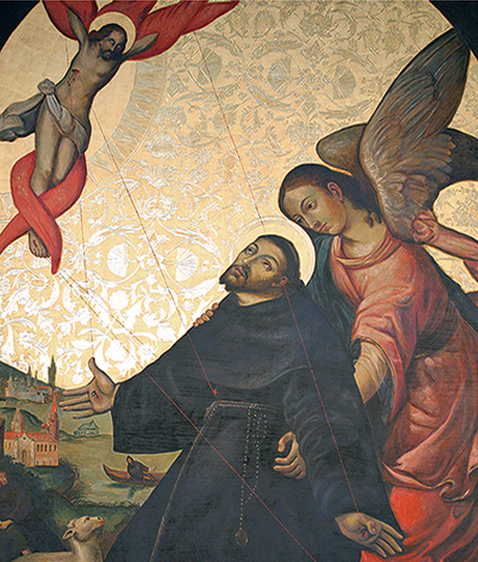
Main altar. Made of wood in 1724 at the workshop of Bartlomiej Bernatowicz. The original altar was almost completely destroyed during the bombardment on August 30th, 1944. It was faithfully recreated from old pictures in the years 1973 – 1983. The altarpiece consists of 2 tiers. On the first tier, in between double rows of columns, a painting depicting the Stigmatization of St. Francis, which refers to the name of this church and which was painted by prof. Jozef Nykiel of Krakow in 1982. It is a true copy of the original from the first, wooden church (currently in the National Museum in Warsaw), which was painted by Mateusz Bertowicz (aka Matthias Kargen) and bought by the citizens of Warsaw in 1664 for the Franciscan church.
The altar painting has a curtain (operated with a special mechanism on first Fridays of each month) in the form of a painting depicting The Divine Mercy by Szymanski (1982). The glorified Christ, Lord of the World, is at the top of the second tier and is surrounded by figures, allegories of the three divine virtues: faith (with the cross), hope (outstretched hands) and love (nursing mother). At the altar feet (the so called antepedium) an imprint of the Last Supper made in 1939 on a silver plated copper plate by a well known goldsmith and engraver, Gontarczyk. This is the only complete element salvaged from the pre-war altar.
The following paintings can be found on the presbytery walls:
On the left:
– Vision of blessed Salomea (1st half of 18th c., author unknown) – originally in a side altar, in a conch bay on the wall of the chapel of Our Lady.
– Annunciation (mid-18th c., Venetian painter Giovanni Battista Pittoni) – painting given to the Franciscans right after World War II by an unknown donor.
– Christ the Lord in the Garden of Gethsemane (1661, renown Silesian painter Michal Willmann).
– a painting originating from the Cistercian abbey in Lubiaz, offered to the Franciscans in 1952 by the Ministry of Culture & Arts, through the intermediary of the Primate’s Council for the rebuilding of Warsaw churches.
On the right:
– Martyrdom of St. Lawrence (2nd half of 18th c., author unknown) – originally in a side altar, in a conch bay on the wall of the chapel of Our Lady.
– Blessed Rafal Chylinski, Franciscan (1991, author Danuta Duch).
– Holy Family, so called Greater (1860, Italian school, Teofil Jende) – previously stored in the convent, as of 1980 displayed in the church.

In the right hand transept the altar of St. Anthony of Padua by B. Bernatowicz, circa 1718-24. The foundation of the altar (antepedium) is in stone, other elements are wooden. The altarpiece is two-tiered. On the sides of the first tier there are 2 wooden, gilded statues from mid-18th c.: St. Elisabeth of Hungary (giving alms) and St. Adalbert (holding an oar). In the centre of the altar the original painting of St. Anthony from 1664 by the royal servitor Mateusz Bertowicz (aka Mathias Kargen) donated to the Franciscan church by the citizens of Warsaw.
The altar is crowned with an ornate cornice which rests on wooden, gilded columns decorated with Corynthian capitals. On the second tier of the altar, among silver-plated clouds, a painting of St. Andrew the Apostle. The painting is supported by angels. The altar as such (seriously damaged in 1939 and 1944) was carefully reconstructed in 1956.
In the left hand transept a wooden altar of the crucified Christ made at the workshop of Bartlomiej Bernatowicz around 1718-24. The altarpiece is two-tiered. On the first tier in between two columns a beautiful, realistic sculpture of Jesus on the cross dated 1694 by a renown German sculptor and architect, Andreas Schülter. A gilded crown of thorns and a loincloth were added in the 1st half of 18th c. Below, figures from the Lamentation Group: Mary Magdalene holding the swooning Virgin Mary (a very rare iconographic composition) and St. John (1st half of 18th c., Bernatowicz workshop).
On the second tier of the alterpiece – gilded clouds, in the centre of which angels supporting the oval frame of the painting depicting the Virgin Mary holding the dead body of Jesus, the so called Pieta (canvas from mid-18th c., unknown author, Warsaw school). The Pieta originated from the Holy Cross Church (in Zoliborz district of Warsaw) which was demolished by the Tsarist authorities at the time of construction of the Citadel after 1831. The sculptural composition includes also 2 angels standing on consoles, on both sides.
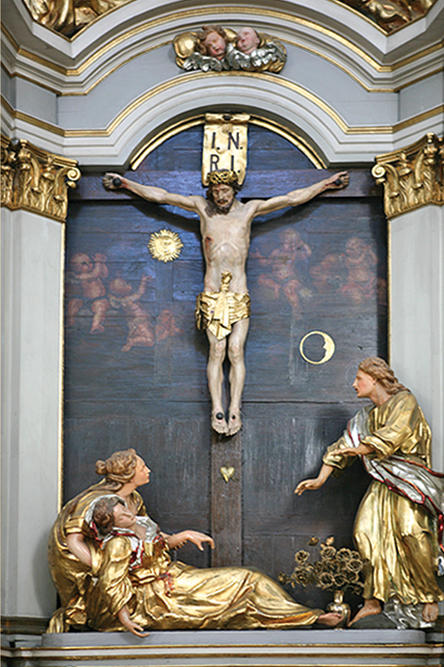
On the left of the presbytery a chapel of Our Lady of Consolation, built along with the presbytery in 1690-97. In the 2nd half of 18th c. the chapel’s ceiling was decorated with splendid frescoes with eucharistic themes by Franciszek Smuglewicz. During the 1944 Warsaw Uprising the chapel was greatly damaged and all the frescoes were lost.
On the sides of the current altar, which was carefully reconstructed – 2 stone triangular columns crowned with gilded, wooden capitals.
In the centre, a painting of Our Lady with Baby Jesus by unknown author (18th c.), decorated with an intricate, silver cover (2nd half 19th c.). The altarpiece is crowned with a dove in glory (a symbol of the Holy Spirit) and 2 gilded angels. At the feet of the altar on both sides 2 figures made of linden wood sculpted by Wincenty Bogaczyk: St. Francis of Assisi (1926) and St. Joseph (1931).

The following paintings can be found on the chapel walls –
On the left:
– Annunciation (around 1844 by Feliks Rybinski).
Previously the painting was in one of the church side altars.
– Our Lady of Passau (2nd half of 17th c., author unknown).
It is possible that this painting was part of the decoration of the earlier, wooden church.
– St. Stanislaus resurrecting the knight Piotrowin (1st half of 18th c., author unknown).
Previously this painting was part of one of the church side altars.
On the right:
– St. Joseph of Cupertino (around 1770, author unknown).
The canvas was badly damaged during the 1944 Warsaw Uprising. After renovation until the 1970’s it adorned the altar on the wall of the right transept next to the presbytery (currently the altar with the painting of Divine Mercy).
– St. Vitalis, a.k.a. Clement (around 1950 by prof. Kazimierz Kwiatkowski).
This painting is an interesting combination of the 4th century martyr with elements of Warsaw architecture.
– St. Michael the Archangel trampling the dragon (1st half of 19th c. by Maciej Rybinski, copy of the 17th c. painting by Guido Reni), painted on sheet metal.
A niche in the left hand wall:
The relics of St. Vitalis (a.ka. Clement), a Roman martyr from the beginnings of 4th c.. The relics are laid in a waxen figure and a glazed sarcophagus. They were brought to Warsaw in 1746 and used to be kept in a special crypt behind the chapel altar. The crypt was destroyed during the 1944 Warsaw Uprising and was not rebuilt.
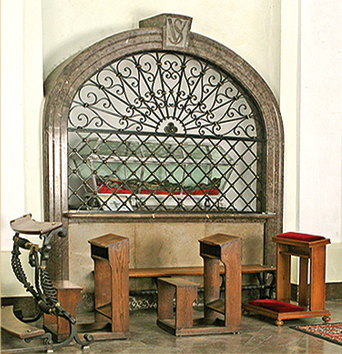
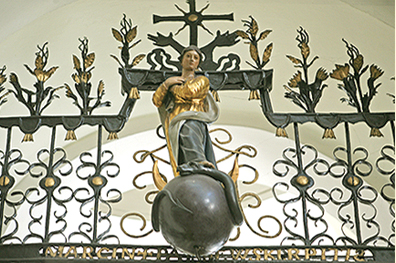
The chapel of Our Lady is separated from the presbytery by a forged baroque grate with a gilded inscription showing the founder’s name and date of its creation: “Marcin Paclowski AD 1772”. On the lintel – a figure of Our Lady of the Immaculate Conception (badly destroyed during World War II).
In between the grate and the altar of the crucified Christ an unusual find discovered in 2014 during conservation works – an exposed brick, which faces the interior of the church and which until recently was covered by plaster, with a Latin inscription “Redime mae ab calumnis hominum” (redeem me from human calumnies) done still before the brick was baked.
On the wall where the left transept meets the presbytery, before the Second World War was an altar with a painting of St. Cecilia. Both were completely destroyed during the bombardment of the church on 30th August 1944 and were never restored.
Baroque pulpit – originally situated on the center pillar, built around 1713-25 thanks to the efforts of the guardian Fr. Gabriel Welisewicz and a donation by the then castellan of Troki Jan Fryderyk Sapieha (a gilded cartouche with his coat of arms is still there on the back of pulpit). On the top of the canopy – a figure of St. Anthony with a lily and an open Gospel Book. Slightly below that – figures of four angels, the so called “putti”, showing the main characteristics of a preacher: constancy (column), righteousness (scales), humility (whipping post)… The pulpit was quite faithfully reconstructed (in part from original elements) in 1964-67 and set closer to the presbytery.

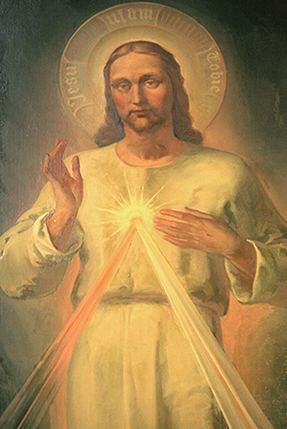
On the wall, where the right transept meets the presbytery – an altar dedicated to Divine Mercy. The painting dated 1946-47 is by prof. Kazimierz Kwiatkowski. A similar painting, done for our church by the same author during the German occupation, was burnt by the German Nazis right after the 1994 Warsaw Uprising. On the sides of the altar – wooden figures: priest Aaron (liturgical vestments) and lawmaker Moses (who originally was likely holding tablets with the Ten Commandments).
In the middle of the right nave is the oldest altar in our church, originating from 2nd half of 17th c., possibly even from the earlier wooden church. The altarpiece is a two-tiered one. On the sides of the first tier – wooden sculptures: St. John the Baptist and St. John the Evangelist. In the center a copy of the icon of Our Lady of Czestochowa from 1946 by prof. Kazimierz Kwiatkowski. The cover of the painting was made from votives donated by the faithful. An earlier painting of Our Lady of Perpetual Help, so called Greek, was burnt by German Nazis after the fall of the 1944 Warsaw Uprising.
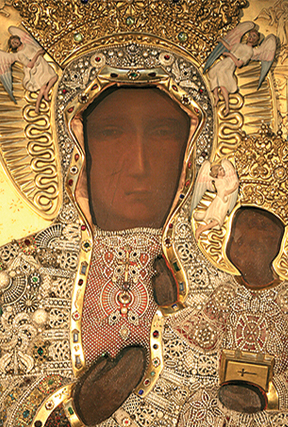

Below the icon, right above the altar – a small 17th c. painting depicting the Last Supper which was painted on a wooden board by an unknown author. On the second tier of the altar – a painting of the Small Holy Family, i.e. Mary with Child and her parents, St. Joachim and St. Anne (1st hald of 18th c., author unknown). On the sides 2 sculptures: St. Barbara (with a tower) and St. Catherine of Alexandria (with a wheel). The altarpiece is adorned with a small figure of the Risen Christ.
In the centre of the left nave – an altar from the beginning of the 18th c. and in it a painting of St. Joseph, Spouse of the Blessed Virgin Mary (copy of original Claude Callot’s painting by Szymon Czechowicz, mid 18th c.). On the upper tier of the altar – a painting depicting the Adoration of the Magi in a gilded frame (author unknown, Venetian school, end of 17th c.).
Under the choir in the right nave – an altar originating from the Holy Cross Church in Zoliborz district of Warsaw, which was demolished by the Tsarist authorities at the time of the construction of the Citadel in the 1830’s. In its centre – a painting of St. Jude Thaddeus, Apostle, patron saint of impossible causes (1945, by prof. Kazimierz Kwiatkowski). On the second tier of the altarpiece – an oval painting showing the Crowning of Our Lady (1st half of 18th c., author unknown). The altar is adorned with a cross, on which there is a dove with gilded rays in the background (a symbol of the Holy Spirit).

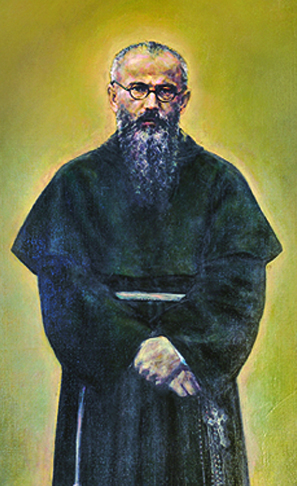
Under the choir in the left nave – an 18th c. altar and a modern painting depicting St. Maksymilian Kolbe, Franciscan, martyr of the German Nazi KL Auschwitz (by Adrian Poloczek, 1982). Originally, the painting of St. Stanislaus resurrecting the knight Piotrowin was placed in this altar (currently in the chapel of Our Lady of Consolation).
Confessionals – intricately made of oak wood by sculptor Wincenty Bogaczyk in years 1926-28. Each of six confessionals is adorned with a different figure sculpted in lime wood. These are in sequence: St. Michael the Archangel; The Prodigal Son; Guardian Angel guiding a young man; Cherubim with a flaming sword in his right hand and scales of justice in the left; Jesus Anointed by a Sinful Woman and an Angel blessing with a raised cross. These confessionals were relatively unscathed during the 1944 Warsaw Uprising and as such can be admired in almost all of their original glory.

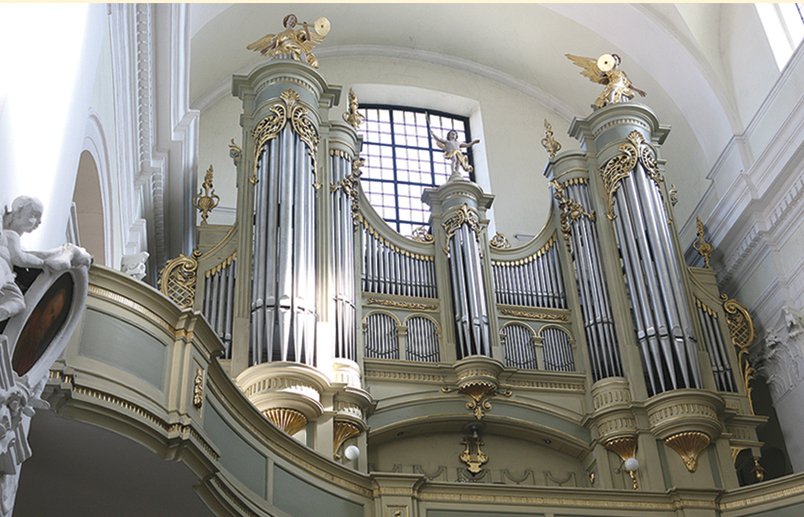
The organ – built in 1926-27, thanks to the efforts of Fr. Florian Koziura. The original 18th c. small instrument was replaced with a new 32-pipe organ which was manufactured by the workshop of Waclaw Biernacki. The baroque style organ front was designed by Henryk Marconi and sculpted by Wincenty Bogaczyk. During the 1944 Warsaw Uprising the instrument was seriously damaged. Initial repairs were carried out by the Biernacki’s workshop. After that in 1954-55 the Sokolowski workshop fitted the missing pipes for a total number of 30.
In the years 1717-19 the cross in the left entryway under the choir was placed at the cemetary which was situated right in front of the church, where the current Zakroczymska street is. When the cemetary was closed down the crucifix, as a valuable memento, was transferred to its current location in the church. There is an inscription under the feet of Jesus Christ embossed in a copper plate: JHS ALL THAT PASS BY, LOOK AT THE WOUNDS OF THE CRUCIFIED. HEAD BOWED READY TO KISS AND HEART OPEN TO LOVE, HANDS OUTSTRETCHED FOR AN EMBRACE, WHOLE BODY READY TO REDEEM. DAY 10 APRIL YEAR 1717.
Commemorative epitaphs – here are the most notable ones:
– Franciszek Mokronowski, standard-bearer of the Warsaw Land (+1733) – in the form of an oval portrait, coat of arms and a rectangular stone epitaph tablet, inscribed in a stucco decoration with military motives.
– Wladyslaw Grzegorzewski, castellan of Ciechanow, general of the crown army, participant in the Battle of Vienna, benefactor of the convent and founder of the bell in 1721 (+1758). Consists of an oval portrait of the deceased and a granite inscription plaque with a cartouche containing the family crest, inscribed in a stucco decoration with military motives (1736).
– Rev. Antoni Kaczanowski, the dean of military chaplains of the Warsaw War District, rector of this church (+1896). Consists of an oval relief of the bust and an inscription plaque.
– Henryk Perzynski, social activist, founder and editor of Everybody’s Daily (+1898). Consists of an oval relief of his face combined with an inscription plaque.

- An 18th c. stone statue of the Our Lady of Grace, the Patroness of Warsaw, can be found outside the church, on the side of Franciszkanska street next to the church apse. In the past it was situated in a niche of the façade of a tenement house at 52, Freta street. In 1952 it was removed from there by the communist authorities. Brought by the faithful to the Franciscans, it underwent several repairs and was placed in the convent garden. As of 2015 the statue is at its current location.
